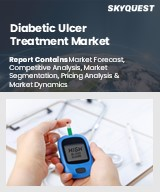
세계의 당뇨병성 궤양 치료 시장 규모는 2023년에 57억 달러에 달하며, 예측 기간(2025-2032년)의 CAGR은 6.1%로, 2024년 60억 5,000만 달러에서 2032년에는 97억 1,000만 달러로 성장할 전망입니다.
세계 당뇨병성 궤양 치료제 시장은 당뇨병 유병률 증가, 기술 발전, 당뇨병성 궤양 합병증에 대한 인식 증가로 인해 크게 성장하고 있습니다. 환자 수가 증가함에 따라 감염을 예방하고 치유 과정을 간소화할 수 있는 효과적인 치료법에 대한 요구가 증가하고 있습니다. 디지털 헬스 솔루션의 통합은 적시에 개입할 수 있을 뿐만 아니라 합병증을 최소화하기 위해 중요한 지속적인 관리를 용이하게 합니다. 당뇨병 치료에 대한 인식이 높아짐에 따라 보다 적극적인 검진과 맞춤 치료 접근이 이루어지고 있으며, 시장 수요는 더욱 증가하고 있습니다. AI, 머신러닝, IoT, 블록체인과 같은 새로운 기술은 조기 발견 강화, 환자 참여도 향상, 보험 프로세스 간소화 등 상황을 완전히 바꾸고 있습니다. 이러한 혁신이 계속 발전하면 환자 결과를 크게 개선하고 다양한 환경에서 최적의 치료를 제공할 수 있습니다.
Global Diabetic Ulcer Treatment Market size was valued at USD 5.7 billion in 2023 and is poised to grow from USD 6.05 billion in 2024 to USD 9.71 billion by 2032, growing at a CAGR of 6.1% during the forecast period (2025-2032).
The global diabetic ulcer treatment market is experiencing significant growth driven by the rising incidence of diabetes, advancements in technology, and heightened awareness of diabetic ulcer complications. An increasing patient base amplifies the need for effective treatments that prevent infections and streamline healing processes. The integration of digital health solutions not only enables timely interventions but also facilitates ongoing management, crucial for minimizing complications. Enhanced awareness around diabetic care has led to more proactive screenings and individualized treatment approaches, further fueling market demand. Emerging technologies like AI, machine learning, IoT, and blockchain are revolutionizing the landscape, enhancing early detection, improving patient engagement, and streamlining insurance processes. As these innovations continue to evolve, they significantly enhance patient outcomes and optimize care delivery across various settings.
Top-down and bottom-up approaches were used to estimate and validate the size of the Global Diabetic Ulcer Treatment market and to estimate the size of various other dependent submarkets. The research methodology used to estimate the market size includes the following details: The key players in the market were identified through secondary research, and their market shares in the respective regions were determined through primary and secondary research. This entire procedure includes the study of the annual and financial reports of the top market players and extensive interviews for key insights from industry leaders such as CEOs, VPs, directors, and marketing executives. All percentage shares split, and breakdowns were determined using secondary sources and verified through Primary sources. All possible parameters that affect the markets covered in this research study have been accounted for, viewed in extensive detail, verified through primary research, and analyzed to get the final quantitative and qualitative data.
Global Diabetic Ulcer Treatment Market Segments Analysis
Global Diabetic Ulcer Treatment Market is segmented by Product Type, Ulcer Type, End User and region. Based on Product Type, the market is segmented into Wound Care Dressings, Wound Care Devices and Active Therapies. Based on Ulcer Type, the market is segmented into Neuropathic Ulcers, Ischemic Ulcers and Neuro-Ischemic Ulcers. Based on End User, the market is segmented into Hospitals, Clinics, Homecare Settings and Others. Based on region, the market is segmented into North America, Europe, Asia Pacific, Latin America and Middle East & Africa.
Driver of the Global Diabetic Ulcer Treatment Market
The rising prevalence of diabetes significantly increases the likelihood of developing ulcers, which in turn drives the demand for innovative treatment options. Factors such as inadequate glycemic control and insufficient awareness about preventive measures further exacerbate the recurrence of ulcers, leading to a persistent need for effective diabetic ulcer treatments. As healthcare systems globally strive to manage the complexities associated with diabetes, there is a sustained and growing demand for reliable ulcer management solutions. This ongoing challenge underscores the critical role of the global diabetic ulcer treatment market in addressing the needs of affected individuals.
Restraints in the Global Diabetic Ulcer Treatment Market
The Global Diabetic Ulcer Treatment market faces significant challenges due to the high cost associated with modern treatment options such as bioengineered skin substitutes, negative pressure wound therapy, hyperbaric oxygen therapy, and growth factor-based treatments. These advanced solutions can place a heavy financial burden on patients, as even in economically developed regions, the lack of insurance coverage for such treatments serves as a deterrent. This financial barrier can prevent individuals from seeking necessary care, ultimately limiting the market's growth potential and accessibility for those suffering from diabetic ulcers.
Market Trends of the Global Diabetic Ulcer Treatment Market
The Global Diabetic Ulcer Treatment market is witnessing a significant trend towards personalized off-loading and preventive care strategies. This shift emphasizes the importance of customized offloading techniques, which are crucial for facilitating the healing process in diabetic ulcers. Patients are increasingly embracing innovative technologies designed to adapt to their unique biomechanics and lifestyles, enhancing treatment efficacy. Concurrently, preventive solutions, including smart socks and pressure-sensing insoles, are becoming popular for their role in proactively managing foot health and preventing ulcer formation. This convergence of personalized care and technological advancement signifies a progressive approach to improving patient outcomes in the diabetic ulcer treatment landscape.